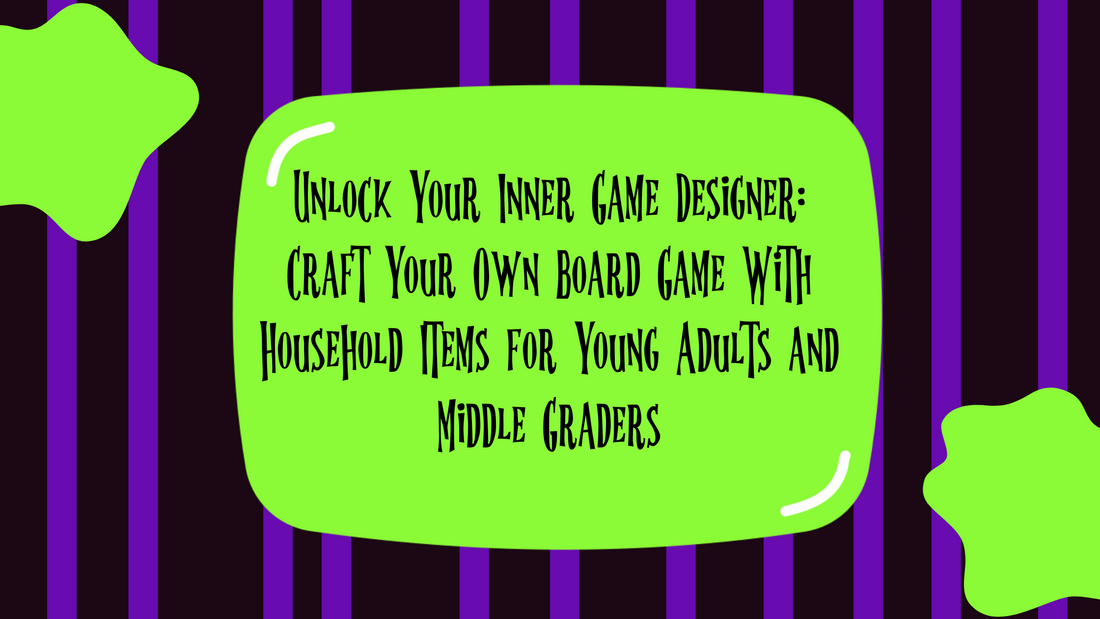As an affiliate, I earn from qualifying purchases, but this doesn't affect the reviews or recommendations—your trust is important to me!
Unlock Your Inner Game Designer: Craft Your Own Board Game With Household Items for Young Adults and Middle Graders

Have you ever found yourself staring at a pile of odd, seemingly unconnected household items and thought, I could design an amazing DIY board game with these!?
Now is the perfect time to unlock your inner game designer and create your own board game. Tapping into this vast reservoir of creativity is not a mission for the faint-hearted. This unique DIY craft, which might turn out to be a metaphor for life, is about navigating challenges, taking chances, and designing your victory path.
Welcome aboard middle graders and young adults, as we embark on this exciting journey of board game creation, opening up avenues for game development and championing the onward march in the realm of creative game design.
Summoning your inner game designer to create a board game
It may sound daunting at first, but with the items already at your disposal, it quickly morphs from being ambitious to achievable. Take a close look around your house. You might gaze upon relics with newfound reverence; that stack of old magazines, those bottle caps, unwanted gift cards, and perhaps even some discarded toys. These are not clutter, but the building blocks of your DIY board game. Crafting your own game with household items not only harnesses your ability to reimagine these items but also unleashes a newfound prowess in game design.
Mapping out your homemade board game
As you embark on mapping out your homemade board game, let the layout arise from both function and aesthetics; let it be a testament to your creative game design. While designing your board game, consider the flow of the game and how your players will traverse through. If you have a deck of cards collecting dust somewhere, deck them out with new roles and rules! Dice, too, can find a rightful place in your game, inserting surprising turns and twists. Leftover holiday baubles could become game pieces - select them based on appeal; they could be visually attractive or nostalgic.
Benefits for young adults and middle graders
For young adults and middle graders, the process of board game creation benefits strict curriculum education, contrasting sharply against usual classroom protocols. With this artful game design project, learning breaks away from the textbook mold and delves into a space that encourages constructive thinking and creativity. The power to design your own board game also provides opportunities to practice valuable skills like problem-solving, strategy planning, and rule-making. These attributes don't just stay on the board; they tend to spill over into day-to-day life, creating well-rounded, inventive individuals.
The joy of craft and personal growth
However, it isn't all about academic and personal growth. Your mind will thoroughly enjoy this workout, and there's something intrinsically joyful about seeing your DIY craft come to life. As your board game starts taking shape, you realize that you're not just playing a game; you're shaping a world with your own rules, characters, and narratives. Consequently, board game crafting becomes an exciting journey of self-exploration and expression, bearing the potential to surprise even the creator. The DIY board game becomes a tangible testament to your unlocked creativity and a symbol of unchartered game development prowess.

25 Essential Materials for Crafting Your Own Board Game at Home
- Recycled cardboard (for board base)
- Old magazines or newspapers (for creating board images)
- Acrylic paints and paintbrushes
- Multi-colored construction paper
- Scissors
- Sketch paper and pencils
- Ruler
- Glue or adhesive tapes
- Different types of markers
- Sticky notes
- Plastic bottle caps (for game pieces)
- Old playing cards (for game instructions or crafting unique cards)
- Dice from old board games
- Old buttons or beads (for game tokens)
- Small toys or lego pieces (for game characters)
- Craft knife (for fine detail cutting)
- Old board game pieces (for inspiration or repurposing)
- Fabric or felt pieces (for creating a game mat or board)
- Compass (for creating perfect circles)
- Hole punch
- String or wool (for creating paths)
- Stencils (for creating specific shapes or letters)
- Poster board (for larger games)
- Googly eyes (for adding character details)
- Clear varnish (to give your game board a professional finish)

Your endeavour to craft a DIY board game from household items
This unravels a world brimming with boundless creativity, a real adventure both for young adults and middle graders. You’ll delight in seeing your seemingly mundane scraps transform into the cornerstones of your personalized board game, whilst experiencing immense satisfaction from nurturing your imaginative prowess. It's not just about designing a game; it's about breathing life into your vision.
Remember, every renowned game designer started somewhere.
Every time you place a fresh piece on your game board or jot down a new rule, you take a step further in your journey of becoming an architect of fun and joy. Your creative challenges won't always be easy; they're not meant to be. But at the end of this, when you see players reveling in the world you've constructed, every hurdle will have been worth it.
So go forth
Let your imagination roam free, setting a thrilling course towards the unexpected and captivating realm of gaming. Winning isn't the ultimate goal, it’s the fun-filled journey, the joyous laughter, the hard-fought victories, and even the sighs of defeat; that's where the magic happens!
Welcome, fellow game designers,
to your first steps in the world of game crafting.
Other Stuff You May Like:
25 Essential Materials for Crafting Your Own Board Game at Home
- Recycled cardboard (for board base)
- Old magazines or newspapers (for creating board images)
- Acrylic paints and paintbrushes
- Multi-colored construction paper
- Scissors
- Sketch paper and pencils
- Ruler
- Glue or adhesive tapes
- Different types of markers
- Sticky notes
- Plastic bottle caps (for game pieces)
- Old playing cards (for game instructions or crafting unique cards)
- Dice from old board games
- Old buttons or beads (for game tokens)
- Small toys or lego pieces (for game characters)
- Craft knife (for fine detail cutting)
- Old board game pieces (for inspiration or repurposing)
- Fabric or felt pieces (for creating a game mat or board)
- Compass (for creating perfect circles)
- Hole punch
- String or wool (for creating paths)
- Stencils (for creating specific shapes or letters)
- Poster board (for larger games)
- Googly eyes (for adding character details)
- Clear varnish (to give your game board a professional finish)











